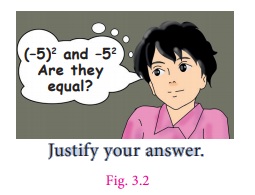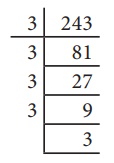Algebra | Term 2 Chapter 3 | 7th Maths - Exponents and Powers | 7th Maths : Term 2 Unit 3 : Algebra
Chapter: 7th Maths : Term 2 Unit 3 : Algebra
Exponents and Powers
Exponents and Powers
We can write large numbers in simplified
form as given below.
For example, 16 =
8 ×
2 =
4 ×
2 ×
2 =
2 ×
2 ×
2 ×
2

Instead of writing the factor 2 repeatedly
4 times, we can simply write it as 24. It can be read as 2 raised to the power of 4 or 2 to the power of 4 or simply 2 power 4.
This method of representing a number is called the exponential form. We say 2 is the base and 4 is the exponent.
Note
The exponent is usually
written at the top right corner of the base and smaller in size when compared to
the base.
Let us look at some more examples,
64 =4×4×4=43 (base is 4 and exponent is 3)
Also, 64 =8×8=82 (base is 8 and exponent is 2)
243 =3×3×3×3×3=35 (base is
3 and exponent is 5)
125=5×5×5=53 (base is 5 and exponent is 3)
Remember, when a number is expressed
as a product of factors and when the factors are repeated, then it can be expressed
in the exponential form. The repeated factor will be the base and the number of
times the factor repeats will be its exponent.
We can extend this notation to negative
integers also. For example,
−125 = (−5) × (−5) × (−5) = (−5)3
[base is ‘ −5 ’ and exponent is 3]
Hence, (−5)3 is the exponential
form of −125 .
MATHEMATICS ALIVE - Algebra in Real Life

In a calculator, multiplication
of two large numbers is displayed as 1.219326E17 which means 1.219326 × 1017 where, ‘E’ stands for exponent
with base 10.
Numbers in Exponential
Form
Now, we will see how to express numbers
in exponential form.
Let us take any integer as ‘a’.
Then, a = a1 [‘a power
1’]
a
× a = a2 [‘a power 2’ ; ‘a’ is multiplied by itself 2 times]
a
× a × a = a3 [‘a power 3’ ; ‘a’ is multiplied by itself 3 times]
: : :
: : :
a × a × a
= a3 (n times) = an [‘a power n’
; ‘a’ multiplied by itself n times]
Thus we can generalize the exponential
form as an, where the exponent is a positive integer (n
> 0)
.
Observe, the following examples.
100 = 10 ×10 = 102
This can also be expressed as the product
of two different bases with the same exponent as, 100=25×4=(5×5)×(2×2)=52
×22
We notice that 5 and 2 are the bases
and 2 is the exponent.
In the same way, a ×
a × a × b ×
b = a 3 × b2
Consider, 35 =
71 × 51 , where there is no repetition of factors. Thus,
usually 71×51 is represented as 7×5. So, when the power is
1 the exponent will not be explicitly mentioned.
Think

Note
1. The exponents 2 and
3 have special names
‘squared’
and ‘cubed’
respectively. For example, 42 is read as ‘four squared’
and 43
is read as ‘four
cubed’.
2. The other name of exponent is indices. Do you remember the word ‘indices’? In Class VI, we heard of this word while applying BIDMAS rule in simplification.
For example,
63 +4×3−5 =(6×6×6)+4×3−5[BIDMAS]
= 216 + (4×3) – 5 [BIDMAS]
= 216 +12–5 [BIDMAS]
= 228 – 5 [BIDMAS]
= 223
Try these
Observe and complete the
following table. First one is done for you.


Example 3.1
Express 729 in exponential form.
Solution

Dividing by 3, we get
729=3×3×3×3×3×3=36
Also, 729 = 9 × 9 × 9 = 93
Example 3.2
Express the following numbers in exponential
form with the given base:
(i) 1000, base 10
(ii) 512, base 2
(iii) 243, base 3.
Solution
(i) 1000 = 10 ×10 ×10 = 103
(ii) 512 =2×2×2×2×2×2×2×2×2=29

(iii) 243 =3×3×3×3×3=35

Example 3.3
Find
the value of (i) 132
(ii) (−7)2 (iii) (−4)3
Solution
Note
(–1)n = –1,
if n is an odd natural number.
(–1)n = 1,
if n is an even natural number.
(i) 132 =
13 ×13
=
169
(ii) (−7)2 =
(−7)
×
(−7)
=
49
(iii) (−4)3
=
(−4)
×
(−4)
×
(−4)
=16 ×
(−4)
= −64
Think
Can you find two positive integers ‘a’ and ‘b’ such
that ab = ba ? ( a ≠ b )
Example 3.4
Find the value of 23 +
32
Solution
23 +32
=(2×2×2)+(3×3)
=8+9=17
Example 3.5
Which is greater 34 or 43
?
Solution
34 =3×3×3×3=81
43 =4×4×4=64
81 > 64 gives 34
>
43
Therefore, 34 is greater.
Example 3.6
Expand a 3b2
and a 2b3. Are they equal ?
Solution
a 3b2 = (a ×
a ×
a) ×
(b ×
b)
a 2b3 = (a ×
a) ×
(b ×
b ×
b)
Therefore, a 3b2
≠
a 2b3
Ancient Tamilians have
used lot of greater numbers in their day-to-day life. Refer to Kanakkathikaram written by a saint Karinayanar
who lived in Tamilnadu during 10th century. More interestingly, they fixed a unique
name for every big number. For example, ‘Arpudham’ means Ten crores, ‘Padmam’ means
1014 , ‘Anantham’ means 1029 and the word ‘Avviyatham’ denotes
1035.
Pingalandai Nigandu Vaipaadu, an ancient Tamil Mathematics
treatise, also confirms the usage of such big numbers. It is a book of multiplication
table.
Related Topics